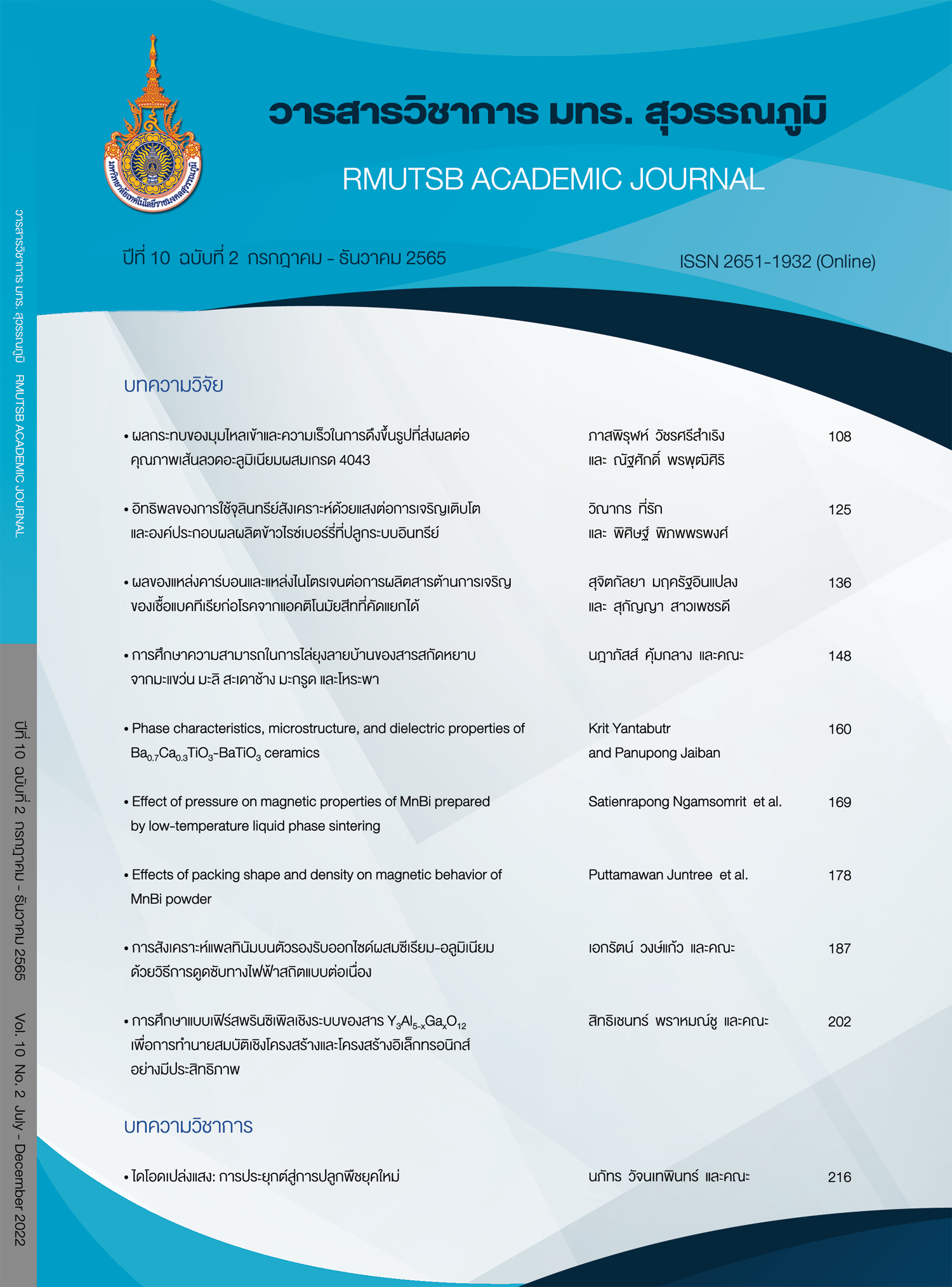Effect of carbon and nitrogen sources on antibacterial substance production from isolated Actinomycetes
Main Article Content
Abstract
Actinomycetes are Gram’s positive bacteria that has the best ability to produce a bioactive compound that inhibited other bacterial growth. This research aimed to isolate, select and study the effect of carbon and nitrogen sources on anti-pathogenic bacterial substances from isolated actinomycetes. Actinomycetes were collected from archaeological site surface in Phranakhon Si Ayutthaya Province. Actinomycetes isolation was isolated using Starch Casein Agar (SCA). The anti-pathogenic bacterial activity was done against 5 pathogenic bacterial strains including Bacillus cereus TISTR 2372, Escherichia coli TISTR 527, Klebsiella pneumonia TISTR 1867, Pseudomonas aeruginosa TISTR 2370 and Staphylococcus aureus TISTR 746 using agar disc diffusion method. The results showed that isolate 1IJ04 had the highest activity on growth inhibition of B. cereus TISTR 2372 with a diameter of inhibition zone of 17 mm. The optimal carbon and nitrogen sources for growth of isolate 1IJ04 were casava starch and monosodium glutamate. This study is the basis study of the diversity of actinomycetes that produce bioactive compounds. This could be benefit for the next antibiotic development.
Article Details

This work is licensed under a Creative Commons Attribution-NonCommercial-NoDerivatives 4.0 International License.
Published manuscript are the rights of their original owners and RMUTSB Academic Journal. The manuscript content belongs to the authors' idea, it is not the opinion of the journal's committee and not the responsibility of Rajamangala University of Technology Suvarnabhumi
References
Abdulla, H., Eric, M., Magdi, B., & Ahmed, D. (2008). Characterization of Actinomycetes isolation from ancient stone and their potential for deterioration. Polish Journal of Microbiology, 57(3), 213-220.
Abraham, J., & Chauhan, R. (2018). Profiling of red pigment produced by Streptomyces sp. JAR6 and its bioactivity. 3 Biotech, 8(1), 22.
Al Farraj, D. A., Rakesh, V, B., Csaba, V. B., Mohamed, S. E., Alokda, A. M., & Mahmoud, A. H. (2019). Antibiotics production in optimized culture condition using low-cost substrates from Streptomyces sp. AS4 isolated from mangrove soil sediment. Science Journal of King Saud University, 32, 1528-1535.
Al Farraj, D. A., Varghese, R., Vagvolgyi, C., Elshikh, M. S., Alokda, A. M., & Mohmoud, A. H. (2020). Antibiotic production in optimized culture condition using low cost substrates from Streptomyces sp. AS4 isolated from mangrove soil sediment. Journal of King Saud University-Science, 32(2), (1528-1535).
Azimi, S., Baserisalehi, M., & Bahador, N. (2014). Evaluation of antimicrobial pigment produced by Streptomyces coeruleorubidus. Nature Environment and Pollution Technology, 13(3), 641-644.
Azimi, S., Salehi, M. B., & Bahador, N. (2016). Isolation and identification of Streptomyces ramulosus from soil and determination of antimicrobial property of its pigment. Modern Medical Laboratory Journal, 1(1), 36-41.
Bayram, S. (2021). Production, purification, and characterization of Streptomyces sp. strain MPPS2 extracellular pyomelanin pigment. Archives of Microbiology, 203, 4419-4426.
Budhathoki, S., & Shrestha, A. (2020). Screening of Actinomycetes from soil for antibacterial activity. Nepal Journal of Biotechnology, 8(3),102-110.
Cheeptham, N., Sadoway, T., Rule, D., Watson, K., Moote, P., Soliman, L. C., Azad, N., Donkor, K. K., & Horne, D. (2013). Cure from the cave: volcanic cave actinomycetes and their potential in drug discovery. International Journal of Speleology, 42(1), 35-47.
El-Naggar, N. A., & El-Ewasy, S. (2017). Bioproduction, characterization, anticancer and antioxidant activities of extracellular melanin pigment produced by newly isolated microbial cell factories Streptomyces glaucescens NEAE-H. Scientific Reports, 7, 42129.
Indrawattana, N., & Vanaporn, M. (2015). Nosocomial infection. Journal of Medicine and Health Sciences, 22(1), 81-92. (in Thai)
Jeffrey, L. H. (2008). Isolation, characterization and identification of actinomyctes from agriculture soil at Semongok, Sarawak. African Journal of Biotechnology, 7(20), 3697-3702.
Jiang, Z., Guo, L., Chen, C., Liu, S., Zhang, L., Dai, S., He, Q., You, X., Hu, X., Tuo, L., Jiang, W., & Sun, C. (2015). Xiakemycin A, a novel pyranonaphthoquinone antibiotic, produced by the Streptomyces sp. CC8-201 from the
soil of a karst cave. The Journal of Antibiotics, 68, 771-994.
Kheiralla, Z. H., Hewedy, M. A., Mohammed, H. R., & Darwesh, O. M. (2016). Isolation of pigment producing Actinomycetes from rhizosphere soil and application It in textiles dyeing. Research Journal of Pharmaceutical, Biological and Chemical Sciences, 7(5), 2128- 2136.
Madigan, M., & Martinko, J. (2006). Brock biology of microorganisms (14th ed.). New York: Pearson Global Edition.
Manasa, M., Poornima, G., Abhipsa, V., Rekha, C., PrashithKekuda, T. R., Onkarappa, R., & Mukunda, S. (2012).
Antimicrobial and antioxidant potential of Streptomyces sp RAMPP-065 isolated from Kudremukh soil, Karnataka, India. Science, Technology and Arts Research Journal, 1(3), 39-44.
Maruekarajtinplaeng, S. (2017). Isolation and study in some character of actinobacteria from archaeological site in Kamphaeng Phet Historical Park with affect biodeterioration. Srinakharinwirot Science Journal, 33(2), 51-69. (in Thai)
Niyomvong, N. (2021). Broad-spectrum antimicrobial compound from Streptomyces coerulescens NN91. Journal of Agriculture, 37(3), 305-351. (in Thai)
Nakaew, N., Pathom-aree, W., & Lumyong, S. (2009). Genetic diversity of rare Actinomycetes from Thai cave and their possible use as new bioactive compounds. Actinomycetologica, 23(2), 21-26.
Rajput, Y., Biswas, J., & Rai, V. (2012). Potentiality test in antimicrobial activity and antibiotic sensibility of subterranean Streptomyces strains isolates from Kotumsar cave of India. International journal of Biological Chemistry, 6(2), 53-60.
Ray, B. (2003). Fundamental food microbiology (3rd ed.). Boca Raton: CRC Press.
Saba, A., Salehi, M. B., & Nima, B. (2016). Isolation and identification of Streptomyces ramulosus from soil and determination of antimicrobial property of its pigment. Modern Medical Laboratory Journal, 1(6), 36-41.
Thompson, C. J., Fink, D., & Nguyen, L. D. (2002). Principles of microbial alchemy: insights from the Streptomyces coelicolor genome sequence. Genome Biology, 3(7), reviews1020.1–reviews1020.4.
Watanadilok, R., Nareeboon, P., & Taweedes, S. (2015). Discovery of bioactive pigments from marine microorganisms (research report). Pathumthani: Faculty of Science, Rangsit University. (in Thai)
Wang, L., Lei, J., Xiang, W., Jiang, S., & Yang, Z. (2009). Identification and characterization of purple pigment-producing actinomycetes strain. China Journal Apply Environment Biotechnology, 15(1), 139-142.
Yucel, S., & Yamac, M. (2010). Selection of Streptomyces isolates from Turkish Karstic cave against antibiotic resistant microorganisms. Pak Journal Pharmaceutical Science, 23(1), 1-6.


